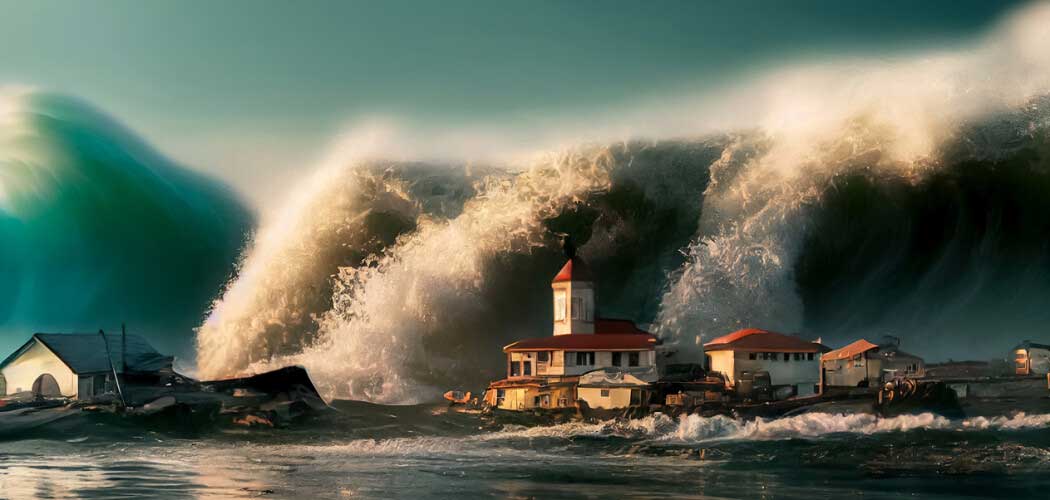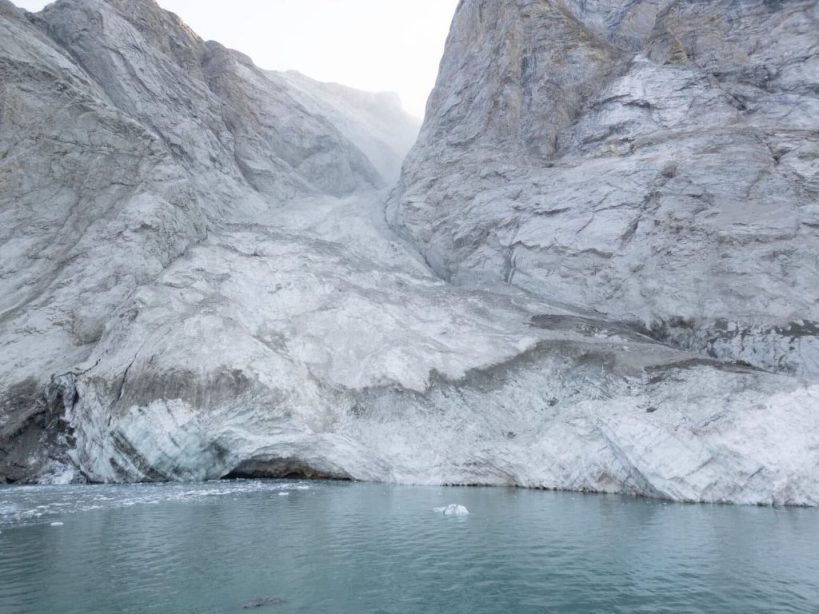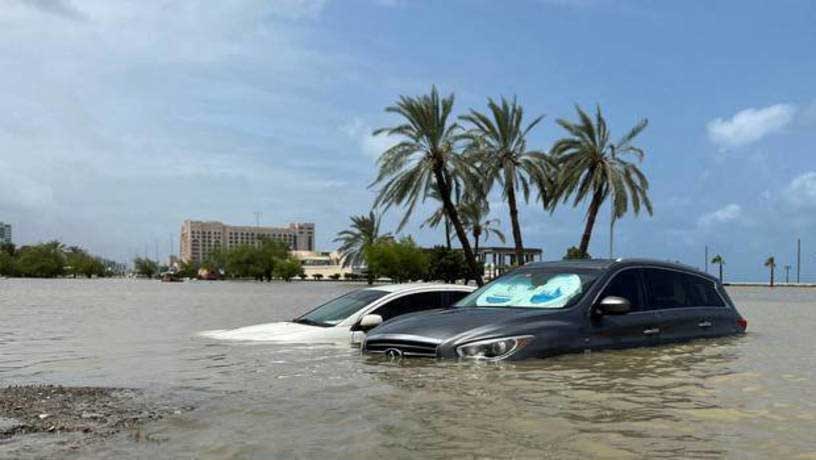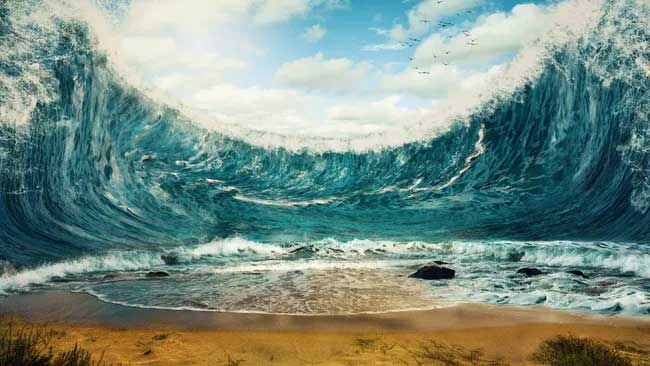Climate change could trigger giant, deadly tsunamis from Antarctica, a new study warns. Sediment shifting beneath the Antarctic seabed could trigger giant tsunamis due to rising ocean temperatures. Fourteen cities and dozens of towns in Russia are vulnerable to tsunamis across three regions of the Far East, with powerful waves capable of hitting their coasts at speeds of up to 1,000 kilometres per hour.
Fourteen cities and several dozen populated areas in Russia are vulnerable to tsunami impacts in three Far Eastern regions; powerful waves could hit their coasts at speeds of up to a thousand kilometers per hour, RIA Novosti reports, citing a warning from the Russian Emergencies Ministry.
In Russia, the coastal areas of Kamchatka, the Kuril Islands, Sakhalin Island and Primorye are subject to tsunami impacts. Rescuers note that the main damaging factor in tsunamis are powerful high waves crashing onto the coast. They spread at high speed (from 50 to 1000 kilometers per hour). The danger of tsunamis also lies in the fact that the first wave is usually followed by a series of repeated, more powerful ones.
According to the ministry, the intensity of the tsunami impact on the coast is assessed on a conditional 6-point scale.

The category “very strong” includes a tsunami of 5 points. In this case, coastal areas are flooded, breakwaters and piers are heavily damaged, and large ships are thrown ashore. The damage is also great in the inner parts of the coast: buildings and structures have strong, medium and weak damage depending on the distance from the coast, in the mouths of rivers there are high storm surges of water. As a result of the impact of such a tsunami, there are human casualties.
A tsunami of magnitude 6 is considered catastrophic. It is characterized by the complete devastation of the coast and coastal areas, the land is flooded for significant distances inland. The scale of the consequences of a tsunami depends on the destructive force of the wave, the nature and natural features of the coast and shore, as well as the effectiveness and timeliness of the measures taken to reduce damage.
Tsunamis are especially dangerous for villages, cities and buildings located on low-lying ocean shores, as well as those located at the top of bays and coves, widely open to the ocean, where tsunamis drive a large mass of water, flooding the mouths and valleys of rivers 2-3 kilometers from the sea. Tsunamis can cause flooding of vast territories with sea water.
Scientists have analyzed the powerful tsunami that hit the coast of Greenland in the fall of 2023. A giant wave 200 m (!) high was caused by an unusually massive landslide sliding into the Dikson Fjord. It was the highest wave on Earth since 1980. The causes of the catastrophic event were only recently revealed.
Melting polar ice has long been at the top of the list of climate change impacts. In the last decade alone, sea levels have risen by 3.8 cm as huge amounts of fresh water enter the oceans each year. Scientists have recently warned that the “slow” rise could pale in comparison to a megatsunami: one that could trigger a wave over 100 meters high in a specific region of the ocean in a matter of minutes, which would then crash onto land.
On September 16, 2023, a football stadium-sized chunk of rock and ice suddenly broke off from a height of about 60 meters in eastern Greenland. The landslide, carrying debris down a steep slope, crashed into a narrow fjord, causing a splash 200 meters high. The tsunami created a seiche: a standing wave that oscillates back and forth in a confined body of water, such as a fjord. In this case, the seiche caused the tsunami wave to be trapped and amplified inside the fjord for about 9(!) days, causing the Earth’s surface to wobble and generate unusual seismic waves around the world. The Greenland landslide and megatsunami of September 2023 caused the entire planet to vibrate for nine days. The unusual vibrations were recorded by sensors around the world.

The researchers studied these seismic signals and satellite images of the area to localize and reconstruct the scenario. Seismological equipment sensed the event as far away as 5,000 km. In general, the unusual signal at monitoring stations used to detect seismic activity was seen on sensors everywhere (from the Arctic to Antarctica) within an hour of the event. The signal, which was initially classified as an “unidentified seismic object,” was unlike any previously recorded. Instead of the multi-frequency hum characteristic of earthquakes, it was a monotonous hum containing only one oscillation frequency. Moreover, the signal did not stop for 9 days (at which time the wave was tearing apart the fjord), which initially caused confusion about what was happening.
Experts believe the main cause of the disaster was accelerated melting of glaciers, which caused destabilization of the rocks. They warn that such giant landslides may become more frequent due to the rapid heating of the planet’s polar regions. The results of the study, described in the journal The Seismic Record, can be used for modeling aimed at predicting other similar events.
Corresponding Member of the Russian Academy of Sciences, Scientific Director of the Institute of Water Problems of the Russian Academy of Sciences Viktor Danilov-Danilyan in an interview with Rossiyskaya Gazeta highlighted a number of current issues related to climate and the development of the “green” agenda. He noted that the intensification and increase in the frequency of natural disasters is one of the manifestations of climate change.
“The prevailing trend is that in regions where flooding was regular, it will happen more often and more severely. It’s a similar story with drought. The climate as a whole is very unbalanced and has become, as climatologists say, nervous.” As an example, the scientist cited the situation with the flooding in the United Arab Emirates – in a region that was completely unprepared for it. In April 2024, several Gulf countries received almost a year’s worth of rainfall in one day (and in some places, even more than the annual norm) – an exceptional event recorded in climate history. The extreme torrential rain caused flash floods across the region. Oman and the UAE were particularly affected; at least 32 people died in the countries.

According to Danilov-Danilyan, there is no need to panic. But such phenomena require increased attention, all necessary protective measures should be carried out more professionally, and the same dams should be monitored (he cited Orsk as an example). “After all, we have the necessary technological base. In addition, we can always order the appropriate R&D to check on computer models whether the designed structure will work or not,” the scientist commented.
In general, according to the expert, the climate doctrine is a fully working document, which should be followed by specific measures. One of them is, for example, a working system of carbon polygons. “But the implementation of any program, as well as its development, should be strictly controlled. Only then can the standards effectively work to preserve the environment and not turn into fiction,” the scientist believes.
Thus, the Volga recovery project included research work on diffuse pollution. It accounts for approximately 60% of the total negative impact on water bodies. This is 1.5 times higher than the pollution rates from wastewater. There are individual areas where diffuse pollution accounts for up to 90%. The results of such research must be implemented in the current programs for the recovery of our rivers, lakes and seas.
Climate change could trigger giant, deadly tsunamis from Antarctica, a new study warns. The shifting of sediment beneath the Antarctic seafloor could trigger giant tsunamis due to rising ocean temperatures.
By drilling sediment cores hundreds of feet beneath the seafloor in Antarctica, scientists have found that previous periods of global warming — 3 million and 15 million years ago — created loose layers of sediment that shifted, causing powerful tsunamis that swept toward the shores of South America, New Zealand and Southeast Asia.
And as climate change warms the oceans, the researchers believe there is a chance these tsunamis could happen again. Their findings were published May 18, 2024, in the journal Nature Communications.
“Underwater landslides are a major geohazard that can trigger tsunamis that can cause enormous loss of life,” said Jenny Gales, a lecturer in hydrography and ocean science at the University of Plymouth in the UK, in a statement. “Our findings highlight the urgent need to improve our understanding of how global climate change may affect the stability of these regions and the potential for future tsunamis.”
Researchers first discovered evidence of ancient landslides off the coast of Antarctica in 2017 in the eastern Ross Sea. Beneath these landslides were layers of soft sediment filled with fossilized sea creatures known as phytoplankton.

An artistic illustration of a tsunami wave about to hit a beach
Scientists returned to the area in 2018 and drilled deep into the seafloor to extract sedimentary cores – long, thin cylinders of crust that reveal layer by layer the region’s geological history.
By analyzing the sediment cores, the scientists learned that the layers of weak sediment formed during two periods: one about 3 million years ago during the mid-Pliocene warm period, and the other about 15 million years ago during the Miocene climate optimum. During these eras, the waters around Antarctica were 5.4 degrees Fahrenheit (3 degrees Celsius) warmer than they are today, leading to outbreaks of algal blooms that, when they died, filled the seafloor below with rich, slippery sediment, making the region prone to landslides.
The exact cause of past underwater landslides in the region is unknown, but researchers have found the most likely culprit: melting glacial ice due to a warming climate. The end of Earth’s periodic ice ages caused ice sheets to shrink and retreat, easing the load on Earth’s tectonic plates and causing them to bounce upward in a process known as isostatic rebound.
Once the layers of weak sediment had accumulated in sufficient quantity, the uplift of the Antarctic continent caused earthquakes, which caused the coarse gravel lying on top of the slippery layers to slide off the edge of the continental shelf, causing landslides that generated tsunamis.
The scale and size of ancient ocean waves are unknown, but scientists have noted two relatively recent underwater landslides that generated huge tsunamis and caused significant loss of life: the 1929 Grand Banks tsunami, which produced 42-foot (13-meter) waves and killed about 28 people off the coast of Newfoundland, Canada; and the 1998 Papua New Guinea tsunami, which produced 49-foot (15-meter) waves and killed 2,200 people.
With layers of sediment buried beneath Antarctica’s seafloor and glaciers slowly melting on its surface, the researchers warn that if they are right and melting glaciers were the cause of the landslides in the past, the landslides and tsunamis could happen again in the future.




